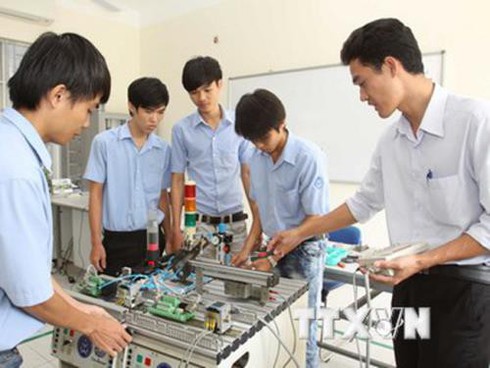 |
|
Vietnam needs highly skilled workforce for national development
|
In its socio-economic development strategy until 2020, Vietnam has identified human resource development as a key to changing the growth model and a foundation for sustainable development and improvement of national competitiveness during international integration.
High-quality human resources means human resources with qualifications, skills, and competencies that can fulfill needed tasks and meet the demands of industrialization and modernization in the 4th Industrial Revolution. Vietnam has adopted several policies to attract or produce talented, high-quality human resources.
Abundant human resources
High-quality human resources benefit rapid and sustainable growth of the economy and are vital to mobilizing and effectively using other resources, particularly in the development of a knowledge-based economy.
Vietnam has abundant human resources, with 76% of its population in the workforce, the third highest in ASEAN. Vietnam is in a period of “golden population structure”, with a young, high-potential workforce.
"We have more than 55 million workers, most of them young. If we exploit this opportunity, we can create breakthroughs in human resource development," said Truong Anh Dung, Deputy Director General of the General Department of Vocational Training of the Ministry of Labour, Invalids, and Social Affairs,
There are signs that high-quality human resources are growing: Vietnam has expanded skilled vocational training to increase its competitive edge; Vietnam’s vocational training index in the Global Competitiveness Index jumped 13 places last year; and the Vietnamese government has been fine-tuning its human resource policies and diverting more resources to human resource development.
Key directions to create breakthroughs
Competing in the 4th Industrial Revolution means competing in human resources. During its international economic integration, Vietnam needs to meet the labour quality requirements of new-generation Free Trade Agreements. Human resources will improve if curriculums are revised to balance supply and demand between schools and markets.
The Ministry of Labour, Invalids and Social Affairs has invested heavily in vocational training schools, restructuring sectors, and adapting the vocational training programs of more developed countries.
Economist Le Dang Doanh said "Vietnamese vocational training schools have been cooperating with enterprises, especially foreign invested enterprises that use modern technology. This is producing higher-skilled workers who can earn higher incomes."
Meanwhile, Bui Sy Loi, Deputy Head of the National Assembly’s Committee for Social Affairs, stated that Vietnam should focus, not just on young trainees, but also on the millions of workers who are already working in various sectors, particularly in the garment, textile, and footwear industries.
"The Government and the Ministry of Labour, Invalids, and Social Affairs are on the right track in steering students and vocational training curriculums toward high-demand skills," said Loi.
Restructuring the vocational training sector and expanding cooperation between schools and enterprises are the key to increasing Vietnam’s human resource quality. VOV
 Human resources are vital for any country and a measure of social progress, equality, and sustainable growth.
Human resources are vital for any country and a measure of social progress, equality, and sustainable growth.